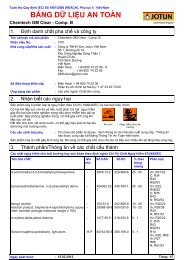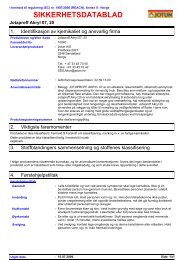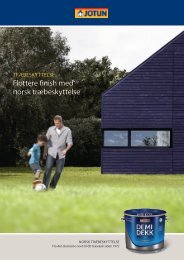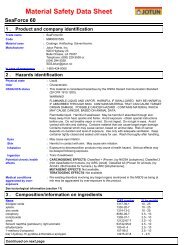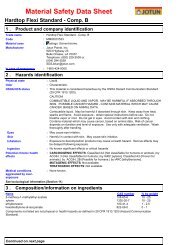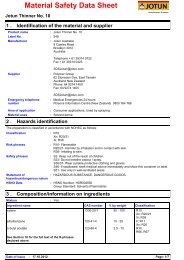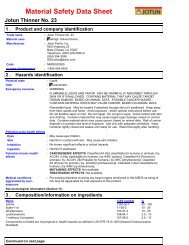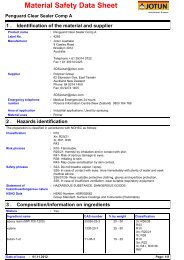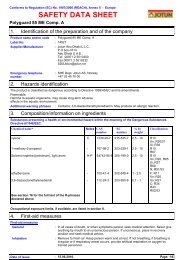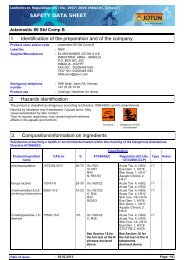Material Safety Data Sheet - Jotun
Material Safety Data Sheet - Jotun
Material Safety Data Sheet - Jotun
You also want an ePaper? Increase the reach of your titles
YUMPU automatically turns print PDFs into web optimized ePapers that Google loves.
SeaMate Red Page: 4/98 .Exposure controls/personal protection8 hrs OEL: 10 mg/m³ 8 hour(s). Form: Dust8 hrs OEL: 5 mg/m³ 8 hour(s). Form: FumeCA British Columbia Provincial (Canada, 6/2008).STEL: 10 mg/m³ 15 minute(s). Form: RespirableTWA: 2 mg/m³ 8 hour(s). Form: RespirableCA Ontario Provincial (Canada, 6/2008).STEV: 10 mg/m³ 15 minute(s). Form: The notation “respirable”following the name of an agent in this Schedule means that size fractionof the airborne particulate deposited in the gas-exchange region of therespiratory tract and collected during air sampling with a particle sizeselectivedevice that, (a) meets the American Conference ofGovernmental Industrial Hygienists (ACGIH) particle size-selectivecriteria; and (b) has the cut point of 4 microns at 50 per cent collectiveefficiency.TWAEV: 2 mg/m³ 8 hour(s). Form: The notation “respirable” followingthe name of an agent in this Schedule means that size fraction of theairborne particulate deposited in the gas-exchange region of therespiratory tract and collected during air sampling with a particle sizeselectivedevice that, (a) meets the American Conference ofGovernmental Industrial Hygienists (ACGIH) particle size-selectivecriteria; and (b) has the cut point of 4 microns at 50 per cent collectiveefficiency.CA Quebec Provincial (Canada, 6/2008).TWAEV: 5 mg/m³ 8 hour(s). Form: fumeSTEV: 10 mg/m³ 15 minute(s). Form: fumecolophonyCA Quebec Provincial (Canada, 6/2008). Skin sensitizer.TWAEV: 0,1 mg/m³, (formaldehyde) 8 hour(s).titanium dioxide CA British Columbia Provincial (Canada, 6/2008).TWA: 3 mg/m³ 8 hour(s). Form: Respirable dustTWA: 10 mg/m³ 8 hour(s). Form: Total dustCA Quebec Provincial (Canada, 6/2008).TWAEV: 10 mg/m³ 8 hour(s). Form: Total dust.CA Ontario Provincial (Canada, 6/2008).TWAEV: 10 mg/m³ 8 hour(s). Form: total dustCA Alberta Provincial (Canada, 6/2008).8 hrs OEL: 10 mg/m³ 8 hour(s).ethylbenzene CA Alberta Provincial (Canada, 6/2008).8 hrs OEL: 100 ppm 8 hour(s).8 hrs OEL: 434 mg/m³ 8 hour(s).15 min OEL: 543 mg/m³ 15 minute(s).15 min OEL: 125 ppm 15 minute(s).CA British Columbia Provincial (Canada, 6/2008).TWA: 100 ppm 8 hour(s).STEL: 125 ppm 15 minute(s).CA Ontario Provincial (Canada, 6/2008).TWAEV: 100 ppm 8 hour(s).TWAEV: 435 mg/m³ 8 hour(s).STEV: 125 ppm 15 minute(s).STEV: 540 mg/m³ 15 minute(s).CA Quebec Provincial (Canada, 6/2008).TWAEV: 100 ppm 8 hour(s).TWAEV: 434 mg/m³ 8 hour(s).STEV: 125 ppm 15 minute(s).STEV: 543 mg/m³ 15 minute(s).Solvent naphtha (petroleum), light aromatic ACGIH TLV (United States, 1/2005).TWA: 123 mg/m³ 8 hour(s). Form: All formsTWA: 25 ppm 8 hour(s). Form: All forms1-methoxy-2-propanol CA Alberta Provincial (Canada, 6/2008).15 min OEL: 553 mg/m³ 15 minute(s).15 min OEL: 150 ppm 15 minute(s).8 hrs OEL: 369 mg/m³ 8 hour(s).8 hrs OEL: 100 ppm 8 hour(s).CA British Columbia Provincial (Canada, 6/2008).STEL: 75 ppm 15 minute(s).Continued on next page
SeaMate Red Page: 5/98 .Exposure controls/personal protectionTWA: 50 ppm 8 hour(s).CA Ontario Provincial (Canada, 6/2008).STEV: 550 mg/m³ 15 minute(s).STEV: 150 ppm 15 minute(s).TWAEV: 365 mg/m³ 8 hour(s).TWAEV: 100 ppm 8 hour(s).CA Quebec Provincial (Canada, 6/2008).STEV: 553 mg/m³ 15 minute(s).STEV: 150 ppm 15 minute(s).TWAEV: 369 mg/m³ 8 hour(s).TWAEV: 100 ppm 8 hour(s).Engineering measuresPersonal protectionEyesSkinRespiratoryHands :Hygiene measures: Use only with adequate ventilation. Use process enclosures, local exhaust ventilation orother engineering controls to keep worker exposure to airborne contaminants below anyrecommended or statutory limits. The engineering controls also need to keep gas, vaporor dust concentrations below any lower explosive limits. Use explosion-proof ventilationequipment.:::<strong>Safety</strong> eyewear complying with an approved standard should be used when a riskassessment indicates this is necessary to avoid exposure to liquid splashes, mists ordusts.Personal protective equipment for the body should be selected based on the task beingperformed and the risks involved and should be approved by a specialist before handlingthis product.Use a properly fitted, air-purifying or air-fed respirator complying with an approvedstandard if a risk assessment indicates this is necessary. Respirator selection must bebased on known or anticipated exposure levels, the hazards of the product and the safeworking limits of the selected respirator.Chemical-resistant, impervious gloves complying with an approved standard should beworn at all times when handling chemical products if a risk assessment indicates this isnecessary.: Wash hands, forearms and face thoroughly after handling chemical products, beforeeating, smoking and using the lavatory and at the end of the working period. Appropriatetechniques should be used to remove potentially contaminated clothing. Washcontaminated clothing before reusing. Ensure that eyewash stations and safety showersare close to the workstation location.9 .Physical and chemical propertiesPhysical stateFlash pointColorOdorRelative densityVOC: Liquid.: Closed cup: 25°C (77°F): Red.: Characteristic.: 1.72 g/cm 3: 3.45 pounds/gallon (US)14.35 pounds/gallon0 % (w/w)Solubility:Insoluble in the following materials: cold water and hot water.Section 10. Stability and reactivityStability and reactivityHazardous decompositionproductsHazardous polymerization:::The product is stable.Under normal conditions of storage and use, hazardous decomposition productsshould not be produced.Under normal conditions of storage and use, hazardous polymerization will notoccur.Continued on next page
SeaMate Red Page: 6/9Section 11. Toxicological informationChronic effects on humansOther toxic effects onhumansSpecific effectsCarcinogenic effectsMutagenic effectsReproduction toxicityChronic effectsTarget organs12 .Ecological information:::::::CARCINOGENIC EFFECTS: Classified A4 (Not classifiable for humans or animals.)by ACGIH, 3 (Not classifiable for humans.) by IARC [xylene]. Classified A4 (Notclassifiable for humans or animals.) by ACGIH [zinc oxide]. Classified + (Proven.) byNIOSH [colophony]. Classified 3 (Not classifiable for humans.) by IARC [zineb].Classified A3 (Proven for animals.) by ACGIH, 2B (Possible for humans.) by IARC[ethylbenzene].Contains material which causes damage to the following organs: eye, lens or cornea.Contains material which may cause damage to the following organs: blood, kidneys,lungs, liver, gastrointestinal tract, upper respiratory tract, skin, central nervoussystem (CNS).Exposure to component solvent vapor concentrations in excess of the statedoccupational exposure limit may result in adverse health effects such as mucousmembrane and respiratory system irritation and adverse effects on the kidneys, liverand central nervous system. Solvents may cause some of the above effects byabsorption through the skin. Symptoms and signs include headache, dizziness,fatigue, muscular weakness, drowsiness and, in extreme cases, loss ofconsciousness. Repeated or prolonged contact with the preparation may causeremoval of natural fat from the skin, resulting in non-allergic contact dermatitis andabsorption through the skin. If splashed in the eyes, the liquid may cause irritationand reversible damage. Swallowing may cause nausea, diarrhea, vomiting, gastrointestinalirritation and chemical pneumonia.Contains rosin, zineb. May produce an allergic reaction.Contains material which may cause cancer, based on animal data. Risk of cancerdepends on duration and level of exposure.No known significant effects or critical hazards.No known significant effects or critical hazards.Contains material that can cause target organ damage.Contains material which causes damage to the following organs: eye, lens or cornea.Contains material which may cause damage to the following organs: blood, kidneys,lungs, liver, gastrointestinal tract, upper respiratory tract, skin, central nervoussystem (CNS).Ecotoxicity dataProduct/ingredient name Species Period Resultdicopper oxide Daphnia (EC50) 48 hour(s) 0.51 mg/lxyleneOncorhynchus mykiss (LC50)Oncorhynchus mykiss (LC50)Lepomis macrochirus (LC50)Lepomis macrochirus (LC50)Lepomis macrochirus (LC50)Pimephales promelas (LC50)96 hour(s)96 hour(s)96 hour(s)96 hour(s)96 hour(s)96 hour(s)3.3 mg/l8.2 mg/l8.6 mg/l12 mg/l13.3 mg/l13.4 mg/lzinc oxideDaphnia magna (EC50)Oncorhynchus mykiss (LC50)Lepomis macrochirus (LC50)Pimephales promelas (LC50)48 hour(s)96 hour(s)96 hour(s)96 hour(s)>1000 mg/l1.1 mg/l>320 mg/l2246 mg/ltitanium dioxide Daphnia magna (EC50) 48 hour(s) >1000 mg/lethylbenzeneSolvent naphtha (petroleum), lightaromaticbis(1-hydroxy-1h-pyridine-2-thionatoo,s)copperContinued on next pageDaphnia magna (EC50)Daphnia magna (EC50)Selenastrum capricornutum(EC50)Oncorhynchus mykiss (LC50)Pimephales promelas (LC50)Poecilia reticulata (LC50)Fish (LC50)Daphnia (EC50)Algae (IC50)Fish (LC50)Daphnia (EC50)48 hour(s)48 hour(s)48 hour(s)96 hour(s)96 hour(s)96 hour(s)96 hour(s)48 hour(s)72 hour(s)96 hour(s)48 hour(s)2.93 mg/l2.97 mg/l7.2 mg/l4.2 mg/l9.09 mg/l9.6 mg/l
SeaMate Red Page: 7/912 .Ecological informationAlgae (IC50) 120 hour(s) 0.035 mg/lEnvironmental precautionsProducts of degradation13 .Disposal considerationsWaste disposal: Very toxic to aquatic organisms, may cause long-term adverse effects in the aquaticenvironment. Water polluting material. May be harmful to the environment if released inlarge quantities.::Products of degradation: carbon oxides (CO, CO2) and water, nitrogen oxides (NO, NO2etc.), sulfur oxides (SO2, SO3 etc.), halogenated compounds. Some metallic oxides.The generation of waste should be avoided or minimized wherever possible. Emptycontainers or liners may retain some product residues. This material and its containermust be disposed of in a safe way. Dispose of surplus and non-recyclable products viaa licensed waste disposal contractor. Disposal of this product, solutions and any byproductsshould at all times comply with the requirements of environmental protectionand waste disposal legislation and any regional local authority requirements. Avoiddispersal of spilled material and runoff and contact with soil, waterways, drains andsewers.Disposal should be in accordance with applicable regional, national and local laws and regulations. Localregulations may be more stringent than regional or national requirements.The information presented below only applies to the material as supplied. The identification based oncharacteristic(s) or listing may not apply if the material has been used or otherwise contaminated. It is theresponsibility of the waste generator to determine the toxicity and physical properties of the material generated todetermine the proper waste identification and disposal methods in compliance with applicable regulations.Refer to Section 7: HANDLING AND STORAGE and Section 8: EXPOSURE CONTROLS/PERSONAL PROTECTIONfor additional handling information and protection of employees.Section 14. Transport informationRegulatoryinformationUN numberProper shippingnameClass PG* Label AdditionalinformationDOT Classification3009Copper basedpesticide, liquid,toxic, flammable(bis(1-hydroxy-1hpyridine-2-thionatoo,s)copper,xylene)6.1 III-TDG Classification 3009 Copper based 6.1pesticide, liquid,toxic, flammable(bis(1-hydroxy-1hpyridine-2-thionatoo,s)copper,xylene)III-ADR/RID Class3009 Copper basedpesticide, liquid,toxic, flammable(bis(1-hydroxy-1hpyridine-2-thionatoo,s)copper,xylene)6.1 IIITunnel restrictioncode: (D/E)Hazard identificationnumber: 63Continued on next page
SeaMate Red Page: 8/9Section 14. Transport informationIMDG Class3009 Copper basedpesticide, liquid,toxic, flammable(bis(1-hydroxy-1hpyridine-2-thionatoo,s)copper,xylene).Marine pollutant(dicopper oxide, zincoxide)6.1 IIIEmergency schedules(EmS): F-E, S-DMarine pollutant: Yes.IATA-DGR Class 3009 Copper basedpesticide, liquid,toxic, flammable(bis(1-hydroxy-1hpyridine-2-thionatoo,s)copper,xylene)6.1 III-PG* : Packing group-15 .Regulatory informationWHMIS (Canada):Class B-2: Flammable liquidClass D-1B: <strong>Material</strong> causing immediate and serious toxic effects (Toxic).Class D-2A: <strong>Material</strong> causing other toxic effects (Very toxic).Class D-2B: <strong>Material</strong> causing other toxic effects (Toxic).CEPA Toxic substances: None of the components are listed.Canadian ARET: None of the components are listed.Canadian NPRI: The following components are listed: Xylene; Ethylbenzene; Zinc;Copper; Copper; Light aromatic solvent naphthaAlberta Designated Substances: None of the components are listed.Ontario Designated Substances: None of the components are listed.Quebec Designated Substances: None of the components are listed.This product has been classified in accordance with the hazard criteria of the Controlled Products Regulations andthe MSDS contains all the information required by the Controlled Products Regulations.EU regulationsHazard symbol or symbols :ToxicDangerous for theenvironmentRisk phrases:R10- Flammable.R23- Toxic by inhalation.R21/22- Harmful in contact with skin and if swallowed.R43- May cause sensitization by skin contact.R50/53- Very toxic to aquatic organisms, may cause long-term adverse effects in theaquatic environment.Continued on next page
SeaMate Red Page: 9/915 .Regulatory information<strong>Safety</strong> phrases :S23- Do not breathe vapor / spray.S36/37- Wear suitable protective clothing and gloves.S38- In case of insufficient ventilation, wear suitable respiratory equipment.S45- In case of accident or if you feel unwell, seek medical advice immediately (showthe label where possible).S61- Avoid release to the environment. Refer to special instructions/safety data sheet.16 .Other informationDate of issueVersionNotice to reader::29.03.2010.1To the best of our knowledge, the information contained herein is accurate. However, neither the above-namedsupplier, nor any of its subsidiaries, assumes any liability whatsoever for the accuracy or completeness of theinformation contained herein.Final determination of suitability of any material is the sole responsibility of the user. All materials may presentunknown hazards and should be used with caution. Although certain hazards are described herein, we cannotguarantee that these are the only hazards that exist.Indicates information that has changed from previously issued version.



